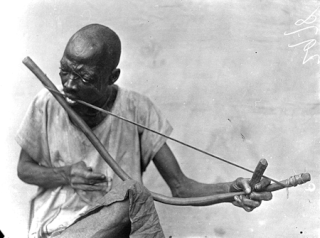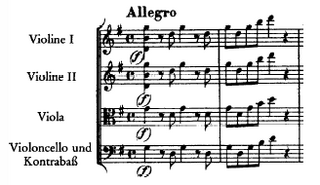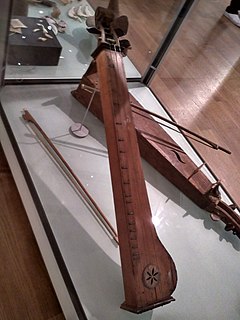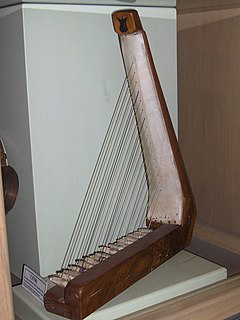Related Research Articles

The cello ( CHEL-oh; plural celli or cellos) or violoncello ( VY-ə-lən-CHEL-oh; Italian pronunciation: [vjolonˈtʃɛllo]) is a bowed (sometimes plucked and occasionally hit) string instrument of the violin family. Its four strings are usually tuned in perfect fifths: from low to high, C2, G2, D3 and A3. The viola's four strings are each an octave higher. Music for the cello is generally written in the bass clef, with tenor clef, or alto clef, and treble clef used for higher-range passages.

The double bass, also known simply as the bass, is the largest and lowest-pitched bowed string instrument in the modern symphony orchestra. Similar in structure to the cello, it has four, although occasionally five, strings.

The violin, sometimes known as a fiddle, is a wooden chordophone in the violin family. Most violins have a hollow wooden body. It is the smallest and thus highest-pitched instrument (soprano) in the family in regular use. The violin typically has four strings, usually tuned in perfect fifths with notes G3, D4, A4, E5, and is most commonly played by drawing a bow across its strings. It can also be played by plucking the strings with the fingers (pizzicato) and, in specialized cases, by striking the strings with the wooden side of the bow.

String instruments, stringed instruments, or chordophones are musical instruments that produce sound from vibrating strings when a performer plays or sounds the strings in some manner.

Pizzicato is a playing technique that involves plucking the strings of a string instrument. The exact technique varies somewhat depending on the type of instrument :

The musical bow is a simple string instrument used by a number of South African peoples, which is also found in the Americas via slave trade. It consists of a flexible, usually wooden, stick 1.5 to 10 feet long, and strung end to end with a taut cord, usually metal. It can be played with the hands or a wooden stick or branch. It is uncertain if the musical bow developed from the hunting bow, though the San or Bushmen people of the Kalahari Desert do convert their hunting bows to musical use.
In music, a bow is a tensioned stick which has hair coated in rosin affixed to it. It is moved across some part of a musical instrument to cause vibration, which the instrument emits as sound. The vast majority of bows are used with string instruments, such as the violin, viola, cello, and bass, although some bows are used with musical saws and other bowed idiophones.
The fingerboard is an important component of most stringed instruments. It is a thin, long strip of material, usually wood, that is laminated to the front of the neck of an instrument. The strings run over the fingerboard, between the nut and bridge. To play the instrument, a musician presses strings down to the fingerboard to change the vibrating length, changing the pitch. This is called stopping the strings. Depending on the instrument and the style of music, the musician may pluck, strum or bow one or more strings with the hand that is not fretting the notes. On some instruments, notes can be sounded by the fretting hand alone, such as with hammer ons, an electric guitar technique.

The erhu is a Chinese two-stringed bowed musical instrument, more specifically a spike fiddle, which may also be called a Southern Fiddle, and is sometimes known in the Western world as the Chinese violin or a Chinese two-stringed.
Frances-Marie Uitti is an American cellist and composer known for her use of extended techniques and performance of contemporary classical music. Tom Service, music critic for the Guardian newspaper, has called her "arguably the world's most influentially experimental cellist."
A slur is a symbol in Western musical notation indicating that the notes it embraces are to be played without separation. A slur is denoted with a curved line generally placed over the notes if the stems point downward, and under them if the stems point upwards.
Prime functions of the slur in keyboard music...are to delineate the extent of a phrase line and to indicate the legato performance of melodies or arpeggiated chords.
Both accents and slurs relate directly to woodwind articulation...(and brass as well) [since they] employ a variety of tonguing effects [which are indicated by use of, "the correct form," of accents and slurs].
[With bowed string instruments] A curved slur over or under two or more notes indicates that these notes are to be connected...Slurs are only partially indicative of phrasing; if an actual phrase mark is necessary, it should be notated above the passage with broken lines.

In music, a double stop is the technique of playing two notes simultaneously on a stringed instrument such as a violin, a viola, a cello, or a double bass. On instruments such as the Hardanger fiddle it is common and often employed. In performing a double stop, two separate strings are bowed or plucked simultaneously. Although the term itself suggests these strings are to be fingered (stopped), in practice one or both strings may be open.

The electric upright bass (EUB) is an instrument that can perform the musical function of a double bass. It requires only a minimal or 'skeleton' body to produce sound because it uses a pickup and electronic amplifier and loudspeaker. Therefore, a large resonating structure is not required to project the sound into the air. This minimal body greatly reduces the bulk and weight of the instrument. EUBs must always be connected to an amplifier and speaker cabinet to produce an adequate audible sound. The EUB retains enough of the features of the double bass so that double bass players are able to perform on it.

Playing the violin entails holding the instrument between the jaw and the collar bone. The strings are sounded either by drawing the bow across them (arco), or by plucking them (pizzicato). The left hand regulates the sounding length of the strings by stopping them against the fingerboard with the fingers, producing different pitches.

The langspil is a traditional Icelandic drone zither. It has a single melody string and usually 2 drone strings.

The imzad is a single-string bowed instrument used by the Tuareg people in Africa.

The çeng is a Turkish harp. It was a popular Ottoman instrument until the last quarter of the 17th century.

The curved bow for string instruments enables string players to control the tension of the bow hair in order to play one, two, three and four strings simultaneously and to change easily among these possibilities. The high arch of the bow allows full, sustained chords to be played and there is a lever mechanism that affects the tension and release of the bow hair. The stick of the curved bow is bent upwards (convex) and forms a circle segment. Since the four strings of a string instrument are arranged on a curved bridge, the bow hairs must be loosened so that they can reach all three or four strings. Currently used bow sticks are slightly bent in the other direction (concave), that is it is only possible to play two strings at a time and, for a short time with a lot of bow pressure, three strings simultaneously.

Playing the cello is done while seated with the instrument supported on the floor. The fingertips of the left hand stop the strings on the fingerboard to determine the pitch of the fingered note. The right hand plucks or bows the strings to sound the notes.
References
- 1 2 Claudot-Hawad, H. (1986). "Ahardin". Encyclopédie berbère . Vol. 3 | Ahaggar – Alī ben Ghaniya. Aix-en-Provence: Edisud. pp. 311–312. doi:10.4000/encyclopedieberbere.824.